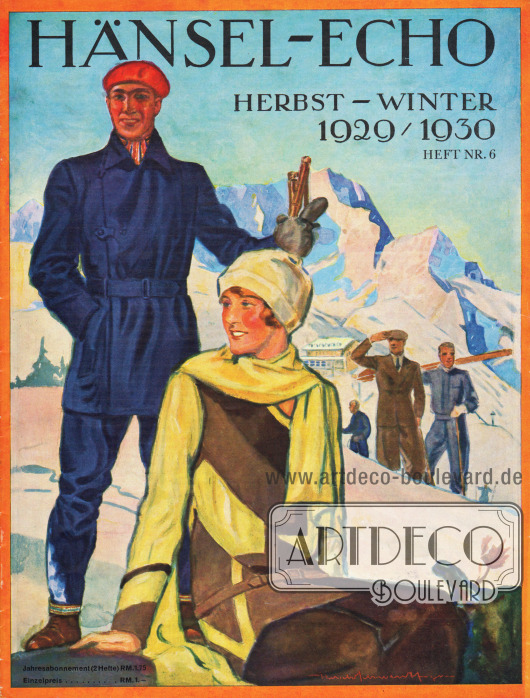|
P. 1 |

|
Front page of the autumn/winter issue of the company magazine Hänsel-Echo No. 6 from 1929.
Drawing/illustration: Harald Schwerdtfeger (1888-1956).
|
|
P. 2 |
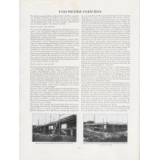
|
Article:
Henschke, Bruno, And further forward.
The contribution to the enlargement and expansion is accompanied by two photographs below. The captions are "Spring 1929: Extension of the warp twisting mill in Plant II" and "Summer 1929: New warp twisting mill completed. Extension of the horsehair twisting mill. 17 m x 72 m".
|
|
P. 3 |

|
Article:
Henschke, Bruno, The Fashion for Fall and Winter 1929/30. A fashion letter.
Hansel-Echo newsletter to the Hansel friends. Publishing company Hänsel & Co. / horsehair twisting and weaving mill, Forst (Lausitz, Germany).
|
|
P. 4 |
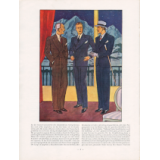
|
Article:
Henschke, Bruno, The Fashion for Fall and Winter 1929/30. A fashion letter.
The most important part of the men's wardrobe is the jacket suit. The fashionable silhouette of the jacket in the autumn of 1929 shows itself in wide shoulders, which are not square but not round either, in a well emphasized waist and sliding hips. The lapels are worked straight or rising, but always wide. The breast pocket - for handkerchiefs - is cut diagonally. Whether the gentleman prefers to wear a single-breasted or a double-breasted suit is up to his personal taste.
Worsted yarns, smooth, patterned or roughened, firm and loose fabrics like saxons, heavy gabardine and cheviots are the preferred fabrics of the season. Checks, dots, sprinkles, melanges, figure designs and stripes in distinctly small patterns are preferred.
Drawing/illustration: Harald Schwerdtfeger (1888-1956).
|
|
P. 5 |
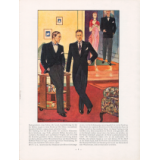
|
Article:
Henschke, Bruno, The Fashion for Fall and Winter 1929/30. A fashion letter.
For special private or official business visits as well as for smaller meals or for 5 o'clock tea, the combined suit - similar to the Stresemann - is worn. This consists of a black jacket, black and white striped or silver trousers, which should be worn with a light, double-breasted vest.
The cutaway (middle of the picture) is even more festive. The cut is only worn with striped pants. The jacket is worn with a button through. The lap should be cut as narrow as possible and fall pleasingly; patches at waist and lap give the jacket a better shape. At the back, above the split lap fold, there are two decorative buttons at waist height.
Drawing/illustration: Harald Schwerdtfeger (1888-1956).
|
|
P. 6 |
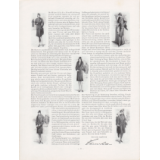
|
Article:
Henschke, Bruno, The Fashion for Fall and Winter 1929/30. A fashion letter.
The article will feature five small drawings showing a tailor-made jacket dress, a costume and three autumn coats for ladies. The lady's coat at the bottom right is a double-breasted paletot.
|
|
P. 7 |
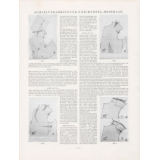
|
Article:
Henschke, Bruno, underarm treatment and Hansel horsehair.
The article is supplemented by four detailed drawings that demonstrate the cutting of the Hänsel fabric and the accurate production of a jacket armpit.
Illustration/Drawing: Hänsel-Echo.
|
|
P. 8 |
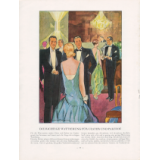
|
Article:
Henschke, Bruno, The Right Padding for Ulster and Paletot.
A tuxedo and tails are indispensable for the evening. The tuxedo is usually single-breasted and is closed on one button. Similar to the jackets for the day, the lapels are very wide. However, the lapels of the tuxedo and tailcoat are often trimmed with shiny silk.
The tailcoat is worked with three buttons. The front parts stand about 20 cm apart. The lapels are so narrow and lie so far back that the gentleman can put his hands into the pockets without any problems.
The vests for tuxedo and tailcoat are mostly made of linen batiste or wash linen.
Drawing/Illustration: Harald Schwerdtfeger (1888-1956).
|
|
P. 9 |
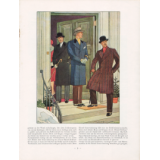
|
Article:
Henschke, Bruno, The Right Padding for Ulster and Paletot.
Street paletots. The basic shape of the street paletots corresponds to the Chesterfield mantle. It is worked with a concealed button facing, under which three buttons sit. Finely melanged fabrics in Melton weaves or in not too smooth Cheviots, which can also be patterned in themselves, are used with preference.
Two-row paletots are worked in dark fabrics with silk lining and velvet collar. For slim figures (first paletot) an average can also be worked at the waist.
Drawing/illustration: Harald Schwerdtfeger (1888-1956).
|
|
P. 10 |
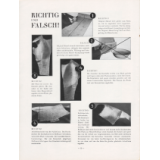
|
Right and wrong!
1. CORRECT! original Hansel is immediately cut from the piece and processed further.
2. WRONG! Never soak, moisten, iron or otherwise treat the original Hansel yourself.
3. CORRECT! The plaque is piqued under the whole piece.
4. CORRECT! The patches of the whole piece are covered by the flock and are next to the flock patches, not above them.
5. CORRECT! lateral axis incision. The incisions run along the weft in Hansel horsehair.
6. CORRECT! Axial incisions from the armpit.
Photos: Hänsel-Echo.
|



